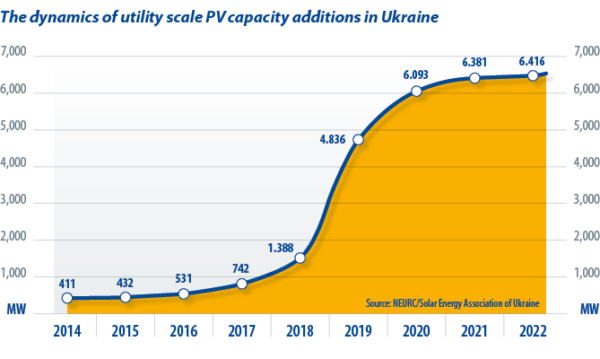From pv magazine 06/23
The European Electricity Review 2023, published by clean energy think tank Ember, says EU solar electricity generation grew by 24% to 203 TWh last year, from 164 TWh in 2021. That increase brought the share of solar in the EU electricity mix to 7.3%. The European Union increased solar generation capacity from 103 GW in 2018 to 209 GW in 2022. Capacity could rise 54 GW this year, in a medium scenario, or up to 68 GW.
Ukrainian PV mirrors the European trend, albeit slower. In 2019, pre-pandemic and before the latest invasion, Ukraine was in the top five fastest growing European solar markets, with 4 GW of solar added annually. Utility projects almost halted last year, with the onset of war, but rooftop solar is growing.
The chart below does not accurately demonstrate the reality facing Ukraine’s solar industry. A Secretariat of the Energy Charter study estimates at least 15% of Ukrainian solar plants – around 1 GW of capacity – are damaged, destroyed, or occupied. Some projects have been affected by theft.

There have also been cases of targeted missile attacks on solar power plants and mines laid at solar projects in recently liberated Ukrainian territory.
Energy infrastructure
Attacks on Ukraine’s energy infrastructure have caused more than $10 billion worth of damage and left more than 12 million people without, or with limited access to, electricity – as well as disrupting water and heating systems. This was the finding delivered by the comprehensive energy damage assessment conducted by the United Nations Development Program and the World Bank.
With regular blackouts across the whole country, renewable energy often becomes the only local source of electricity for municipalities and residents. Significant growth in the residential sector is evident with autonomous or hybrid PV, the latter combined with residential battery storage systems. Ukrainian businesses also follow the trend and are installing solar rooftops to have their own electricity production for consumption.
Ukraine benefits from the advantages of the renewable energy technology in the country’s darkest hour. And the Ukrainian government recently initiated the introduction of a net billing support scheme for solar – instead of feed-in tariffs – for prosumers.
Rebuilding efforts
At the same time, the process of rebuilding Ukraine has already begun and energy has a central place in these early endeavors. Affected solar power plants have already been reconstructed in the Kherson and Kharkiv regions. Some have been fully renovated and have started to supply electricity again. It is very important to have more distributed energy sources for the Ukrainian electricity system as it has suffered from power shortages since October 2022. Conventional power generation facilities damaged by Russian strikes can be replaced by renewable energy.
The prime minister of Ukraine, Denys Shmyhal, says the government intends to actively tap the potential of renewable energy including solar, wind, hydro, and green hydrogen technology. Shmyhal says the Russian attacks are pushing Ukraine towards radical reform by driving a decentralized energy system.
“Then it will be less vulnerable to enemy attacks,” says the PM. “We are talking about the creation of mini power plants and small generation facilities implemented in the existing energy system.”
The Solar Energy Association of Ukraine estimates that, under its “energy transition” scenario, the nation’s installed capacity of PV should reach at least 17 GW by 2030. The plans are to reach up to 20 GW of installed solar capacity for residential buildings and communal buildings by the end of the decade.
Ukraine has very favorable conditions for the development of PV plants and potential for the production of green hydrogen. The country has already started commercial electricity exports to European countries after synchronization with the European Network of Transmission System Operators for Electricity last year.
One of the most important directions of the future development of Ukraine is the deployment of self-sufficient microgrids. Power outages caused by numerous missile attacks and the resultant blackouts in the fall of 2022 have raised the topic of microgrids based on renewables up the agenda. Microgrids can include solar power plants, small wind power facilities, bio- and small hydropower plants, and storage systems.
Microgrids are almost impossible to eliminate with missiles if there are several thousand of them in a country of the size of Ukraine. The technology has huge potential for local and foreign investment as part of the reconstruction of Ukraine.
Despite the war, Ukrainian solar companies are helping the nations of the EU to achieve energy independence. Ukraine is also a participant in the European solar industry, for instance in the production of mounting systems. Ukrainian engineering, procurement, and construction services companies have significant experience in the installation of solar energy facilities, having built more than 5 GW of generation capacity in Ukraine, the Baltic region, and elsewhere in Europe.
Learn more about the Solar Energy of Association of Ukraine and its members in pavilion A3.153 at the Intersolar exhibition, from June 14 to June 16, 2023.
 About the author: Artem Semenyshyn is head of the Ukrainian solar association and a consultant on renewables, the energy transition, and sustainability. With a PhD in commercial law and a BA in international management, Semenyshyn is an energy transition adviser to the deputy prime minister of Ukraine, a guest lecturer, a senior researcher, and a volunteer member of the supervisory board of charitable foundation RePower Ukraine.
About the author: Artem Semenyshyn is head of the Ukrainian solar association and a consultant on renewables, the energy transition, and sustainability. With a PhD in commercial law and a BA in international management, Semenyshyn is an energy transition adviser to the deputy prime minister of Ukraine, a guest lecturer, a senior researcher, and a volunteer member of the supervisory board of charitable foundation RePower Ukraine.
The views and opinions expressed in this article are the author’s own, and do not necessarily reflect those held by pv magazine.
This content is protected by copyright and may not be reused. If you want to cooperate with us and would like to reuse some of our content, please contact: editors@pv-magazine.com.



By submitting this form you agree to pv magazine using your data for the purposes of publishing your comment.
Your personal data will only be disclosed or otherwise transmitted to third parties for the purposes of spam filtering or if this is necessary for technical maintenance of the website. Any other transfer to third parties will not take place unless this is justified on the basis of applicable data protection regulations or if pv magazine is legally obliged to do so.
You may revoke this consent at any time with effect for the future, in which case your personal data will be deleted immediately. Otherwise, your data will be deleted if pv magazine has processed your request or the purpose of data storage is fulfilled.
Further information on data privacy can be found in our Data Protection Policy.